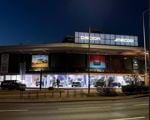"We have been volume dealers and then got out of volume, but fundamentally we’ve always been specialist car sellers.”
"We have been volume dealers and then got out of volume, but fundamentally we’ve always been specialist car sellers.”
"We have been volume dealers and then got out of volume, but fundamentally we’ve always been specialist car sellers.”
"We have been volume dealers and then got out of volume, but fundamentally we’ve always been specialist car sellers.”
Gareth Williams describes the focus in Hatfields, his north of England dealer group, as not being on selling hundreds of cars, but on selling one. That one will lead to another, of course, but it’s Williams’s way of explaining the company’s ethos of engaging with a customer. With a really good plan in place to sell one car, he can feel confident the business will reach its goals.
HATFIELDS
Turnover |
|||||||
Franchise representation
|
|||||||
| Jaguar (5) | |||||||
   |
|||||||
|
Land Rover (3) |
|||||||
 |
|||||||
| Hyundai (1) | |||||||
 |
|||||||
| Volvo (1) | |||||||
|
|||||||
| Chrysler Jeep (3 - service only) | |||||||
 |
|||||||
| Mitsubishi (1 - service only) | |||||||
|
|
|||||||
 |
|||||||
| Hatfields features on the cover of this month's interactive issue of AM magazine. Click here to subscribe | |||||||
That ethos stems from decades retailing Jaguars. The British brand is now the group’s main partner, occupying showrooms in Hull, Liverpool, Sheffield, Shrewsbury and Wakefield.
“First and foremost the volume is low, the loyalty is high and, generally speaking, we know our customers personally. That makes all the difference in the world,” he said.
“The pace of life at which we operate is slower and therefore we can be more precise. It gives you the opportunity to pretty much know exactly what the customer is thinking, whereas too often in this industry you tend to second-guess what your customer is thinking and deliver that in the hope that you’re right.”
He said one of the hardest things for motor retailers today is that selling a car is built on pointing out features and selling the benefits, but today’s buyers often come already armed with that information from internet research. The time then spent in the showroom can too easily become all about the money, the deal.
“Does £5,000 off really make them a satisfied, loyal customer? I believe it is still possible to be a traditional car salesman, because that’s what we do. We’re always selling the essence that is Jaguar, because that’s really how you sell a person one. You’re making them become part of it, giving a different experience.”
Hatfields began retailing for William Lyons, the Jaguar co-founder, in 1922 in Sheffield when he was manufacturing motorcycle sidecars, before his company diverged into making coach-built cars and ultimately became Jaguar after the end of World War II.
It is clear that Williams is immensely proud to be the head of the world’s longest-serving Jaguar dealer. He speaks with a passion for the brand, and serves on its dealer council.
However, the typical Jaguar dealer’s pace of life is set to quicken as franchisees such as Hatfields gear up for more sales opportunities.
Jaguar currently has only five model lines, with which it must compete against German rivals that each have more than four times as many, including fleet cars that young executives aspire to. Jaguar franchisees are desperate for that to change with the arrival in 2015 of the brand’s competitor for the BMW 3 Series and Audi A4. A crossover model is expected to follow later. Jaguar is aiming to reach 50,000 annual registrations in the UK and the corporate saloon and SUV market will be crucial in achieving that.
Williams said dealerships such as his already have facilities that were geared up for last decade’s volume push, when Jaguar had the X-Type compact executive car, so showroom updates should outnumber relocations for much of the network. The end of the X-Type in 2010 left dealers with a hole that has been partly filled by the XF’s strong sales and Williams said the entire Jaguar network has doubled its used car stocks compared with the start of the millennium.
“Jaguar has always been much more about art than science and the dealer network is largely driving that. But we all recognise that with the new products coming, and the volume JLR (Jaguar Land Rover) is looking to derive from Jaguar, that some change is needed with facilities, people and investment. If you look at what it has delivered with Land Rover though, investment in Jaguar seems sensible.![]()
[page-break]
“It’ll be a big slug of money for us because we have five dealerships, but the products coming will definitely sell. If we can have five years like the last five years Land Rover has had then it will all be very worthwhile and Jaguar will be back up there as one of the really great franchises to represent.
“There’s a real sense of anticipation and excitement when you talk to people at Jaguar. As dealers you’re always slightly sceptical because we live very much for today rather than living for tomorrow, but for the first time in a long time as a Jaguar dealer, you can see it will be very different for us in two years’ time.”
But won’t those strong relationships Hatfields has with its customers suffer when it is required to ramp up the volume?
Williams plans to have a larger staff to get the Jaguar experience across to a broader spectrum of buyers. He put it bluntly: “While we may be envious of the Germans and their product range, there’s no point trying to replicate the German service offering. We need to maintain the Jaguar service offering and try to deliver comparable volumes.”
He said Jaguar franchisees have been kept well aware of the plan for phased growth so have had time to prepare.
Hatfields’ philosophy over the years has been to re-invest its profits. Williams said it is in a strong place to invest for the Jaguar expansion and has good support from its bank, RBS. With strong brands and a record of repaying previous borrowings, a sensible operator can get funding for growth at present, he said.
The family-owned group is deliberately managed directly, made possible by owning eight sites less than two hours apart at their furthest point. Williams, his brother, Justin, and his father, John, now in a non-executive chairman role, are the shareholders and directors, alongside Stuart Baldwin, a director responsible for customer service. Beneath them are general managers responsible for each individual site. These are typically local people who will best understand their part of the world and have empathy with the local community.
Concentrating the group along the M62 corridor also helps Hatfields to promote its brand cost-effectively. Williams said he has no interest in marketing to buyers nationally – he wants local touchpoints and local customer referrals.![]()
“We market to our territory because we want those customers back in our workshops,” he said.
The wait for Jaguar to shift up a gear has left the business needing to optimise its other opportunities. In 2013, Hatfields’ used car volume was up 20% and F&I income rose 23%. To achieve this, the group has expanded its used car stocking policy, retailed more non-franchise part-exchanged cars and selected older cars, and broadened its add-on product range with a particular focus on GAP, paint protection, and tyre and alloy wheel insurance.
“We still believed that there was more money to be made out of selling a car and that the additional revenue streams were just that, additional. Whereas in this ever-muddling market you’re never certain necessarily where you’re going to make your profit from. So you make sure that you’re offering everything, because if you end up making nothing from the car, you need to make something from the add-on products.”
Hatfields also changed the pay plans for its salespeople to better reward them for add-on sales. Williams said this wasn’t driven just by the group’s desire for extra revenue, but also was necessary to keep the Jaguar salespeople from leaving in response to the brand’s lack of new models.
“The last thing we can afford is to lose Jaguar salesmen who’ve been with us for years. I don’t want to recruit a load of Audi or BMW salesmen to sell to the Audi and BMW customers who’ll come to us in the future, I want Jaguar people selling Jaguars to those customers, delivering that different experience.”
The tough choices that led Hatfields to a successful turnaround
 |
 |
 |
To outside observers, Hyundai may seem an odd fit in a group otherwise focused on premium brands that appeal to high earners. Managing director Gareth Williams explains that Hatfields took on Hyundai in 2006 when it was a low-volume, niche brand.
It was the quality and value of the cars that made the franchise attractive. Initially, Hatfields represented the Korean brand at four sites – York, Bury, Manchester and Oldham – but the latter two were closed in late 2007. It also exited from its five Chrysler Jeep operations in stages during the past decade as the carmaker battled for survival, replacing one with a Volvo franchise. Hatfields is still an authorised repairer for the US brand.![]()
Regarding the exit from Chrysler Jeep, Williams said what happened to the brand was a pity because Hatfields had held the franchise since 1992 and had a good time with it for 15 years, bringing in new customers its other brands didn’t cater for. But when the strain at Chrysler Jeep started to show, the group lost faith in its new car operation and made the decision to drop it.
It was a tough but essential decision, as Hatfields had been at the receiving end in the past. In 2000, it was a profitable, £100 million turnover group including three Mercedes-Benz franchises. Then the German premium brand decided to restructure its UK network, sacked all its dealers and put the franchise contracts out to tender. The loss cost Hatfields a third of its turnover and two thirds of its profits, and left it with just Jaguar and Chrysler Jeep.
AMi data shows Hatfields’ recent action has led to improved profitability for the remaining business and allowed it to expand elsewhere. In 2009 it opened its first Land Rover dealership in Liverpool, and in 2013 it acquired two more Land Rover dealerships from Pendragon, in Hull and Pickering, at the same time as selling its Worcester Jaguar business, which it had bought from Inchcape in 2007, to Listers.
Those recent changes have been made in order to benefit from economies of scale. Jaguar Land Rover (JLR) is not quite going down the definitive market area route of Mercedes-Benz, however it has a vision of common ownership in a particular market where the opportunity exists.
It has also aimed to broaden its franchisee base a little, which for years has been heavily dominated by the publicly listed motor retailers – at one point Pendragon owned a quarter of UK Jaguar dealerships – and large regional groups.
Williams said Hatfields would love to expand with Jaguar and Land Rover, as would any other dealer in their networks, and it was an unsuccessful bidder for the Farnell Land Rover businesses sold by Co-operative Motor Group to Vertu Motors last year. He’d also like growth with Volvo and Hyundai, which share a location in Bury, and said Hatfields would happily invest for the right opportunities.
With its current structure, Hatfields could comfortably expand to 15 dealerships turning over £250m, Williams said, but he wouldn’t see the point if it couldn’t maintain its strong return on sales.
Login to continue reading
Or register with AM-online to keep up to date with the latest UK automotive retail industry news and insight.


















Login to comment
Comments
No comments have been made yet.